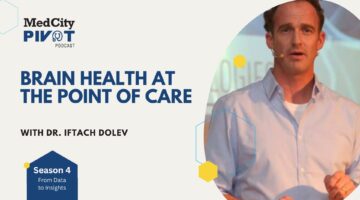
People with intellectual and developmental disabilities (IDD) face some of the deepest oral health disparities in the healthcare system — and the consequences are costly. Higher rates of cavities, gum disease, and tooth loss are driven by limited access to care, provider training gaps, and the sensory and mobility challenges that make routine dental care difficult. Poor oral health doesn’t stay in the mouth, either — it contributes to chronic conditions like heart disease, increasing long-term healthcare costs.
As payers look for smarter ways to improve outcomes and manage spend, one emerging tool deserves serious attention: salivary diagnostics. This non-invasive, real-time diagnosis offers a preventive solution for high-risk populations. It also presents a low-risk opportunity for insurers to evaluate its impact.
Why oral health innovation matters for IDD care & payers
Traditional approaches to dental care often fall short for people with IDD. Routine cleanings can be stressful or inaccessible due to anxiety, sensory sensitivities, mobility issues, or communication barriers. Many dental providers aren’t trained to care for this population, and specialty practices are often out of reach. The result? Preventable dental issues escalate into medical problems, driving avoidable ER visits, worsening chronic disease, and increasing costs — especially for Medicaid plans.
This is where chairside salivary testing has incredible potential. It’s fast, non-invasive, and adaptable to various care settings, including group homes, community clinics, primary care, etc. The test analyzes saliva for markers like pH and MMP-8 to identify early signs of dental disease or systemic inflammation. It gives providers real-time data and helps caregivers tailor interventions before problems become emergencies.
Salivary testing is also gaining national traction. The American Dental Association recently approved a new CDT code for point-of-care saliva diagnostics — clearing a path for broader adoption across clinical settings and reinforcing its role in preventive care.
Early evidence of promise
Pilot studies are valuable tools to demonstrate how salivary testing can work in practice. Early pilot efforts have shown encouraging signals, such as improvements in key biomarkers tied to cavity risk and gum health, as well as better preventive behaviors among participants. While more research is needed, these initial trends highlight the potential of salivary diagnostics to help providers intervene earlier and support high-need populations more effectively.
For payers, the important takeaway is that salivary testing shows promise as a scalable, accessible tool to generate insights and outcomes. Pilots allow insurers to gather real-world data, refine strategies, and assess long-term value — without overhauling existing benefit models.
A low-risk way to test a high-potential solution
For health insurers, the appeal isn’t just clinical; it’s financial. Emergency dental visits alone cost the U.S. healthcare system more than $2 billion annually, with Medicaid covering more than 40% of those costs. Preventive tools that flag risk early and reduce avoidable interventions are a logical next step in bending the cost curve, especially for high-need populations.
Chair-side salivary testing also stands out for its low-barrier implementation. It doesn’t require advanced equipment or clinical infrastructure and can be delivered by support staff in non-traditional care settings. This makes it scalable and well-suited to reaching underserved IDD populations.
That’s why pilot programs are a smart entry point. Payers can explore the impact of salivary testing in a defined population, track clinical and financial outcomes, and gather real-world data — without the need for broad policy changes. Partnering with experienced supplemental benefits providers can ensure efficient rollout, data collection, and analysis with minimal internal lift.
Building a smart, scalable pilot
For payers ready to explore salivary testing, the path forward doesn’t require massive investment — just clear goals, the right partners, and a plan to measure the right metrics. Here are four components needed to launch a focused, high-impact pilot:
Define the scope of your program. Consider starting with high-risk IDD populations — individuals with a history of dental issues or inconsistent access to preventive care. These members will benefit greatly from early intervention and generate clear impact data.
Lean on external expertise. Partner with supplemental benefits administrators who understand the operational demands of specialty care and can ensure smooth execution. They can manage implementation, streamline logistics, and ensure the pilot runs smoothly from the first day.
Measure what matters. A successful pilot delivers more than anecdotes, it generates actionable data. Key metrics can include biomarker changes, fewer emergency visits, better preventive habits, as well as additional outcomes — but the focus should always be on meaningful impact.
Scale the program based on results. If the data shows better outcomes and lower costs, build from there. Use those insights to integrate salivary testing into your benefits strategy — whether as a targeted add-on, a care coordination tool, or a broader preventive offering.
The time to act is now
The oral health needs of people with IDD have gone unaddressed for too long — and the downstream costs are adding up. Salivary testing represents more than a new tool; it’s a scalable strategy to shift care upstream, reduce preventable emergencies, and bring equity to a population too often left behind.
Pilot programs offer health plans a rare combination of low risk and high upside. With early results and real-world implementations already in motion, the question isn’t whether this technology has potential — it’s whether payers are ready to explore it. For those committed to smarter, more inclusive care delivery, it’s time to lead the way.
Picture: Nastasic, Getty Images
Brian Jones is the Chief Growth Officer at Avēsis, a dental and vision specialty benefits provider. Brian leads initiatives that enhance healthcare access and outcomes for Medicaid, Medicare, and other populations with special healthcare needs.
This post appears through the MedCity Influencers program. Anyone can publish their perspective on business and innovation in healthcare on MedCity News through MedCity Influencers. Click here to find out how.











